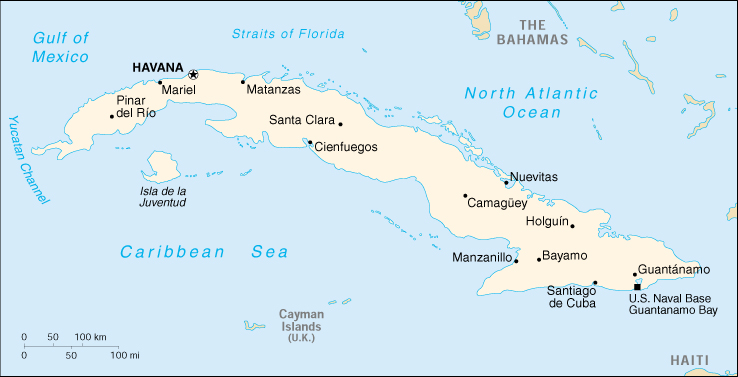| current issue |
| gay mundo |
| bush plus |
| race/class |
| nyc |
| africa |
| americas |
| asia |
| europe |
| arts series |
| gully español |
| about us |
| contact us |
| submit |
| subscribe |
| letters |
| archive |
| action resources |
| search |

The U.S. had evolved from naked colonial, to subtler neo-colonial power in Cuba.

Landless peasants would plant on the sides of roads, until the brutal, machete- wielding police would drive them out.

By Ana Simo
After the 1934 repeal of the Platt Amendment to the Cuban constitution, which allowed the U.S. to intervene at will, Cuba nevertheless remained subservient to the U.S., to which it was now firmly attached by a complex web of economic, geopolitical and military factors. The U.S. had evolved from naked colonial, to subtler neo-colonial power in Cuba.
The Cuba that Castro found in 1959, when he seized power at the head of a populist revolution was not a Haiti, or even a Guatemala. In fact, Cuba was among the least underdeveloped countries in Latin America. It ranked third in life expectancy at birth, fourth in electricity consumption per capita, and fifth in annual income per capita ($353 in 1958).
However, these crude statistics masked shocking inequalities, particularly between the city and the countryside, and between white Cubans, and black and mulatto Cubans.
There was not just one Cuba, but two, perhaps even three Cubas, as far apart one from the other as the Havana of all-white country clubs and glittering casinos was from the city's slums, and these, in turn, from the often desperate countryside.

While Cuban cities had a lively media, as well as more cars and TV sets per capita than practically any other Latin American country, courtesy of the American-style consumerism of the wealthy and the urban middle-class, hunger was a fact of life in rural areas, where some 1.5 million people (25% of the population) struggled to survive.
Big sugar companies kept hundreds of thousands of acres uncultivated, while landless peasants were forced to plant on the sides of roads, until the brutal, machete-wielding rural police, the Guardia Rural, would drive them out.
Peasants joined Castro's rebel army in droves because they had nothing to lose:
• 75% of rural dwellings were huts made from palm trees.
• More than 50% had no toilets of any kind.
• 85% had no inside running water.
• 91% had no electricity.
• There was only 1 doctor per 2,000 people in rural areas.
• More than one-third of the rural population had intestinal parasites.
• Only 4% of Cuban peasants ate meat regularly; only 1% ate fish, less than 2% eggs, 3% bread, 11% milk; none ate green vegetables.
• The average annual income among peasants was $91 (1956), less than 1/3 of the national income per person.
• 45% of the rural population was illiterate; 44% had never attended a school.
Even for most city dwellers, life was not all that rosy.
• 25% of the labor force was chronically unemployed.
• 1 million people were illiterate ( in a population of about 5.5 million).
• 27% of urban children, not to speak of 61% of rural children, were not attending school.
• Racial discrimination was widespread.
• The public school system had deteriorated badly.
• Corruption was endemic; anyone could be bought, from a Supreme Court judge to a cop.
• Police brutality and torture were common.
None of this, however, would have been enough to launch a revolution. It was as much moral revulsion at what Cuba had become, as any specific socio-economic or political gripe, that did it. An entire nation was repulsed with itself: with its perceived corruption, national impotence, and political and economic subservience to the U.S. Castro, a Jacobin moralist at heart, just seized the opportunity.
Related links:
For more on Cuba's history, go to J.A. Sierra's The Timetable History of Cuba.
The Paper Trail:
Eric Williams, From Columbus to Castro: The History of the Caribbean 1492-1969, Vintage Books, New York, 1984.